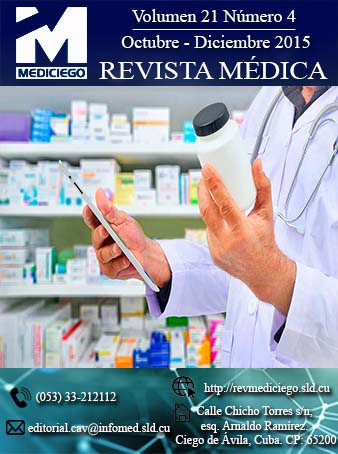Assessment of risk factors for non-variceal upper gastrointestinal bleeding in patients of Provincial General Teaching Hospital “Dr. Antonio Luaces Iraola”. Ciego de Ávila city
Abstract
Introduction: upper gastrointestinal bleeding is a health problem, since its impact is still significant and their consequences can be deadly.
Objective: to identify the possible association between some clinical and epidemiological variables and the occurrence of upper gastrointestinal bleeding.
Method: an epidemiological and causal, retrospective analytical case-control study was performed in patients admitted to the Department of General Surgery at the Provincial General Teaching Hospital "Dr. Antonio Luaces Iraola" of Ciego de Avila city, during the period from April 2012 to March 2014. The sample consisted of 60 patients over 18 years. Chi-square test was used in addition to the Mann-Whitney U test and Odds Ratio calculation to quantify the magnitude of risk.
Results: predominance of male seniors. Gastroduodenal peptic ulcer was the most frequent cause. Regarding the socio-economic status of patients, the middle level prevailed without significant differences between the study groups. Coffee consumption was the most common toxic habit and was significantly higher in the group of patients increasing three times the risk of disease. Consumption of spicy was not found associated with the occurrence of gastrointestinal bleeding, a fact that did happen with the consumption of irritating drugs and the presence of a previous history of digestive tract disease, increasing to twelve times respectively the risk of the entity.
Conclusions: there was association between some clinical and epidemiological variables with the occurrence of upper gastrointestinal bleedingDownloads
Published
How to Cite
Issue
Section
License
Those authors who have publications with this journal accept the following terms of the License CC Attribution-NonCommercial 4.0 International (CC BY-NC 4.0):
You are free to:
- Share — copy and redistribute the material in any medium or format for any purpose, even commercially.
- Adapt — remix, transform, and build upon the material for any purpose, even commercially.
The licensor cannot revoke these freedoms as long as you follow the license terms.
Under the following terms:
- Attribution — You must give appropriate credit , provide a link to the license, and indicate if changes were made . You may do so in any reasonable manner, but not in any way that suggests the licensor endorses you or your use
- No additional restrictions — You may not apply legal terms or technological measures that legally restrict others from doing anything the license permits.
The journal is not responsible for the opinions and concepts expressed in the works, which are the exclusive responsibility of the authors. The Editor, with the assistance of the Editorial Committee, reserves the right to suggest or request advisable or necessary modifications. Original scientific works are accepted for publication, as are the results of research of interest that have not been published or sent to another journal for the same purpose.
The mention of trademarks of specific equipment, instruments or materials is for identification purposes, and there is no promotional commitment in relation to them, neither by the authors nor by the editor.






















